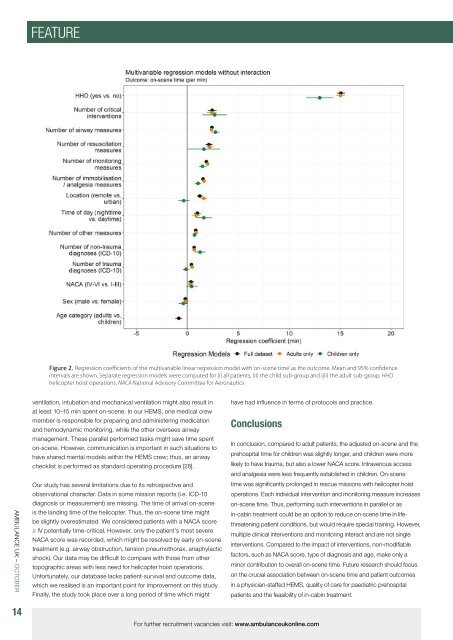Ambulance UK October 2023
Create successful ePaper yourself
Turn your PDF publications into a flip-book with our unique Google optimized e-Paper software.
FEATURE<br />
Figure 2. Regression coefficients of the multivariable linear regression model with ‘on-scene time’ as the outcome. Mean and 95% confidence<br />
intervals are shown. Separate regression models were computed for (i) all patients, (ii) the child sub-group and (iii) the adult sub-group. HHO<br />
helicopter hoist operations, NACA National Advisory Committee for Aeronautics<br />
AMBULANCE <strong>UK</strong> – OCTOBER<br />
ventilation, intubation and mechanical ventilation might also result in<br />
at least 10–15 min spent on-scene. In our HEMS, one medical crew<br />
member is responsible for preparing and administering medication<br />
and hemodynamic monitoring, while the other oversees airway<br />
management. These parallel performed tasks might save time spent<br />
on-scene. However, communication is important in such situations to<br />
have shared mental models within the HEMS crew; thus, an airway<br />
checklist is performed as standard operating procedure [28].<br />
Our study has several limitations due to its retrospective and<br />
observational character. Data in some mission reports (i.e. ICD-10<br />
diagnosis or measurement) are missing. The time of arrival on-scene<br />
is the landing time of the helicopter. Thus, the on-scene time might<br />
be slightly overestimated. We considered patients with a NACA score<br />
≥ IV potentially time-critical. However, only the patient’s most severe<br />
NACA score was recorded, which might be resolved by early on-scene<br />
treatment (e.g. airway obstruction, tension pneumothorax, anaphylactic<br />
shock). Our data may be difficult to compare with those from other<br />
topographic areas with less need for helicopter hoist operations.<br />
Unfortunately, our database lacks patient-survival and outcome data,<br />
which we realised is an important point for improvement on this study.<br />
Finally, the study took place over a long period of time which might<br />
have had influence in terms of protocols and practice.<br />
Conclusions<br />
In conclusion, compared to adult patients, the adjusted on-scene and the<br />
prehospital time for children was slightly longer, and children were more<br />
likely to have trauma, but also a lower NACA score. Intravenous access<br />
and analgesia were less frequently established in children. On-scene<br />
time was significantly prolonged in rescue missions with helicopter hoist<br />
operations. Each individual intervention and monitoring measure increases<br />
on-scene time. Thus, performing such interventions in parallel or as<br />
in-cabin treatment could be an option to reduce on-scene time in lifethreatening<br />
patient conditions, but would require special training. However,<br />
multiple clinical interventions and monitoring interact and are not single<br />
interventions. Compared to the impact of interventions, non-modifiable<br />
factors, such as NACA score, type of diagnosis and age, make only a<br />
minor contribution to overall on-scene time. Future research should focus<br />
on the crucial association between on-scene time and patient outcomes<br />
in a physician-staffed HEMS, quality of care for paediatric prehospital<br />
patients and the feasibility of in-cabin treatment.<br />
14<br />
For further recruitment vacancies visit: www.ambulanceukonline.com
















